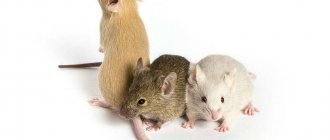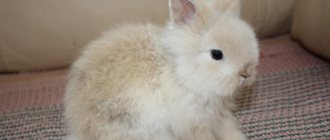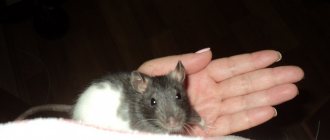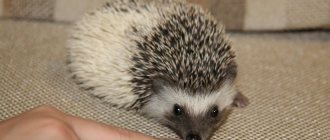Appearance
In appearance, the Siberian hamster resembles a fluffy ball with an inconspicuous tail. It reaches a length of 7-10 cm. The average weight of the animal is 25 g; if kept at home, it can increase to 50 g.
The main color of the hamster is black and gray with a brown longitudinal stripe on the back and a light gray belly. In addition to the usual coloring, sapphire and pearl colors have been bred. On the head are dark, almost black eyes and small ears. The presence of cheek pouches serves to collect and carry food. The short limbs of the paws with five toes are covered with hair.
Buying Syrian hamsters
Such an animal is sold in pet stores, through advertisements or on the market. At the same time, many who want to purchase a Central Asian hamster on the market should be warned, since there is no guarantee of purchasing a healthy animal.
Short-haired types of Syrian hamsters can cost around 300 rubles maximum, while long-haired types are more expensive and will have to pay up to 600 rubles for them.
Buying a Hamster New Pet Syrian Hamster First Day | Elli Di Pets
Characteristics
Most rodent lovers want to know everything about Siberian hamsters. The presence of features in behavior and characteristics is expressed by the following criteria:
- Siberian hamsters are called white Russian dwarf hamsters because of the special property of changing the color of their coat: from gray to white in winter;
- adults lead a calm and slow lifestyle in relation to the young;
- Siberian hamsters are mainly nocturnal. With the onset of darkness, which serves as protection for them from encounters with insidious predators - foxes and owls, they go out in search of food.;
- orientation in space with the help of whiskers allows animals to determine the width of loopholes and the distance between objects;
- rodents easily recognize each other by the smell of the marked territory;
- different-sex individuals of the breed live together only during the mating season, and the rest of the time they live separately and protect their homes from encroachment by other animals;
- with the onset of three months of age, females are able to reproduce with a gestation period of 19 days.
Choosing and arranging a home
To make your pets feel comfortable, it is important to take care of their living conditions.
Dimensions and material
Siberians can be kept either in a cage or in an aquarium, but the first option is more preferable. It is necessary to choose a cage in such a way that it is spacious and can accommodate additional floors. It is also worth paying attention to the distance between the rods - it should not exceed 9 mm.
Find out in more detail how to choose, arrange, and make a cage with your own hands for a hamster.
It is better to purchase cages with iron bars, as hamsters can chew through plastic.
What does a hamster need in a cage?
The following items must be present in the cage:
- House for sleeping. It is necessary so that even during the daytime the fluffy can rest, sleep or simply hide in it.
- Feeder and drinker. Two metal bowls are perfect - the main thing is that they are not light, otherwise the animal will turn them over.
- Running wheel. With the help of this accessory, the rodent will always be able to run when the need arises.
- Mineral stone. It is necessary for grinding down the teeth of hamsters, since too long fangs prevent them from eating food normally. They will also become stronger and clear of dirt.
- Toilet. Such a “separation” in the cage is simply necessary - the baby must know that he should only go to the toilet in a specially designated place. Such devices can be purchased at pet stores.
Where to put it in the room
Little fluffies cannot boast of excellent eyesight, so you should make sure that there is soft light in the cage - this way they can see better.
Important! The cage should not disturb people. You should not place it in a place where it could be accidentally caught (pushed) and dropped on the floor.
Rodents will thrive in rooms with a temperature of 18–25°C. When choosing a location for a cage, you should pay attention to the following recommendations:
- there should be no radiators near the cage;
- You should not place it on the windowsill on the sunny side;
- You cannot place it next to an open window or door;
- rooms with high humidity are not suitable for keeping hamsters;
- You cannot place the cage near electronic equipment.
Choose places without drafts, light, but without direct sunlight.
Natural living environment
In the wild, Siberian hamsters live on hilly and flat steppes. They live alone and in small groups. The established community does not accept adult newcomers. The animals' home is burrows, which they themselves dig in the form of tunnels to a depth of 1.5 meters. A labyrinth of numerous passages provides space for nesting and food storage and reaches a length of up to 8 meters.
Males occupy up to 12 hectares of housing area. The territorial qualities of the hamster's character make it possible to carefully protect the home from uninvited guests. Females settle nearby and are under the care of the stronger sex. Their territory is smaller than that of the male. In winter, rodents have to go into prolonged torpor to survive severe frosts. This process cannot be called full hibernation, because animals have to wake up periodically to consume food.
How to feed?
The easiest way to feed is to use ready-made food, sold in any pet store. They contain a mixture of seeds and grains necessary for proper nutrition of a hamster. Usually one package lasts for a month.
Fruits and vegetables are periodically given as treats. But there should not be too many of them, otherwise the animal may have a bloated belly due to excess carbohydrates. A child will need from 10 to 20 g of “green stuff” per day.
After the next feeding, all leftover food is removed so that it does not spoil and subsequently cause poisoning. Although it is unlikely that scraps will be found in the feeder. The fact is that kids love to stock up “for the winter” by dragging grain in their cheek pouches and hiding them in different corners of the cage. Therefore, the bins are checked and cleaned periodically.
Hamsters usually drink little, since a sufficient amount of liquid comes from succulent food. Despite this, water must be constantly available and changed at least twice a day.
The Siberian is a very cute dwarf animal that will bring joyful bustle and variety into the life of any person.
Fictional breeds
There are about 20 varieties of hamsters on the planet, but sometimes groups of hamsters with certain characteristics are mistakenly classified as separate non-existent breeds. Such fictitious breeds will be discussed in this section.
Albino
Albinos are hamsters whose bodies do not produce the hormone melanin. As a result, they have white fur and red eyes, with blood vessels visible through the colorless iris. They have increased sensitivity to light. Such hamsters are not classified as a separate breed, because this is only a malfunction of the genetic apparatus of a Syrian, Djungarian or any other breed of hamster.
Angora
This is an artificially bred long-haired Syrian hamster. It got its name because of its shaggy coat, which looks like the fur of an Angora goat. Distinctive features are the absence of a tail, small front legs, large cheeks and long hair, which in males reaches 5 cm. The color can be different: spotted, cream, white, black.
Royal
The shaggy golden Syrian hamster is passed off as a royal hamster. But there is no such breed; usually this is done to obtain the greatest benefit.
Black
A black hamster can be a Syrian, Djungarian, or Chinese hamster, because it is not a separate breed, but simply a fur color. Black hamsters are considered animals that do not have any spots of a different color on their body. It is acceptable to have white color on the toes and paws. They are very difficult to breed, which is why they are expensive.
Golden
There is no breed of golden hamster. This is sometimes the name given to Syrian hamsters, whose skin color has a bright golden-sandy hue.
White
White hamsters are usually albinos. They are often passed off as a separate rare species by pet store sellers to make more profit.
Where to place it?
Before you bring a hamster into your home, you need to prepare a place for it to live. If you don't take this seriously, the baby will get lost in a large apartment and die.
Hamsters are not very demanding of the external environment, but feel good at a comfortable temperature of 17 to 26 degrees Celsius.
Everything that is unpleasant for us will not be pleasant for the hamster either. When assigning a cage to a particular place, you should think about whether it will be comfortable for him to be there. Considering the negative impact of some places in the house, we can conclude that you should not install a cage:
- near the radiator;
- on the windowsill, in direct sunlight;
- near operating equipment;
- in a draft;
- in noisy places;
- in bedrooms (taking into account the nocturnal lifestyle of pets).
Article on the topic: Grasshopper hamster, also known as scorpion hamster
Breeding
Golden hamsters are highly fertile. These rodents are capable of producing 3-5 litters per year. The female Syrian hamster is ready to reproduce from the age of 4 months. The male becomes sexually mature at 3 months.
For successful fertilization, a boy and a girl are placed in a spacious cage and live there for some time. After mating, the animals are resettled, since pregnant females become very aggressive.
After 18 days from the moment of fertilization, from 4 to 15 cubs are born. Until 30 days of age, babies feed exclusively on mother's milk, and at approximately 37 days they can already be moved to another cage.
Important! It is advisable to place the cage with the mother and offspring in a quiet, dark place. And the newborns themselves should not be touched with your hands. Otherwise, the female will pick up the alien scent and may eat the cubs.
Syrian hamsters are charming rodents with a pleasant appearance and a sociable, playful disposition. They are not picky in their diet and do not require complex care. If treated correctly, cute animals will become an inexhaustible source of positivity.
What should a cell be like?
A hamster is a rodent, and this should be taken into account when choosing material for housing. A cage with metal bars or an aquarium is suitable for your pet. Siberian hamsters do not have jumping ability, so the aquarium does not need to be covered from above. As for the cage, the distance between the bars should be no more than 7-9 mm, otherwise the animal will try to escape.
The cage itself should be spacious, since the pet needs to run around. It is better to provide a second floor if you need to place play structures. Sawdust is chosen as a floor covering.
The animal will be wary of an empty cage, because humans don’t like living in an apartment without furniture. The hamster's home should be furnished comfortably.
- You will need a house to sleep. In the wild, hamsters live in burrows, so their instinct of self-preservation remains even in cramped cage conditions. They feel safe in the house.
- It is better to secure the feeder and drinker so that the hamster does not turn it over, but you need to make it removable so that it can be washed.
- Mineral stone is necessary for the animal to care for its teeth. By gnawing it, the hamster cleans and strengthens the fangs, and also grinds them down, adjusting them to normal length.
- Running wheel. Siberian hamsters are prone to obesity, so a running wheel is a must for them. It will satisfy their nightly need for movement and allow them to maintain a healthy shape.
- A toilet for a hamster can be purchased at a pet store, and the pet must understand that there is a specially designated place for the toilet.
Caring for an animal, first of all, involves proper nutrition. Twice a day he should be fed grain and kibble formulas, which can be purchased at a pet store. An additional vitamin set consisting of fruits, herbs and vegetables is required. You can add some chicken breast, cottage cheese or an egg to your diet.
Article on the topic: Royal hamster (photo)
As for walking, it does not mean going outside or running around the apartment. Such a walk is dangerous both for the hamster and for the furniture, which he will begin to test. At the pet store you need to purchase a special walking ball that will protect the animal from trouble and allow it to run around to its heart's content.
Your hamster should clean its cage once or twice a week.
A little effort will help your pet always be healthy and happy.
See below for a story about the life of Siberian hamsters.
Diet
In order for your pet to grow up healthy, it is important to provide it with proper nutrition. You need to feed him regularly, twice a day - morning and evening.
Did you know? Dill, plantain and dandelion are a real treat for the animal.
What is possible
The animal's diet must contain grain and granulated mixtures. But you shouldn’t limit yourself only to store-bought food. Include in the menu:
- fruits (including dried);
- vegetables;
- greenery;
- boiled chicken meat;
- egg;
- cottage cheese;
- strawberries;
- raspberries;
- grape.
What not to do
You should not give human food to rodents. It is prohibited to include in the diet:
- fried, salty foods;
- sweet, sour, flour and spicy dishes;
- garlic; beets;
- cabbage;
- onion;
- plum;
- citrus.
Before you get a hamster, find out what to feed it. We recommend reading about what diet is most suitable for hamsters.
The Siberian hamster is a wonderful animal that will bring you and your child a lot of pleasure. However, we should not forget that, like any living creature, rodents need proper care and attention. Their absence can significantly reduce the life expectancy of a fluffy.
Siberian hamster at home
The main concern after deciding to purchase a hamster is finding a cage. Even such a tiny animal needs a spacious cage, since the rodent is particularly mobile, and in order not to limit its movement and ensure comfort, there should be plenty of space. It is possible that the baby will want to take a walk outside his house and try to squeeze between the bars, so the width between them should not exceed 8 mm.
A naturally active hamster needs a properly equipped cage with special equipment, such as tracks, a running wheel, tubes and a small house where the baby can have a good rest.
You need to take a particularly responsible approach to choosing filler for your animal. The best option would be aspen sawdust, as they are considered the safest. Certain types of such bedding have a very negative effect on the animal’s respiratory system. Homemade bedding is not difficult to make from white paper, which is torn into small pieces. Under no circumstances should you use newspapers and magazines that are saturated with ink that is dangerous to the hamster’s body. The litter needs to be changed up to 3 times a week.
Article on the topic: Roborovsky hamster: description, care and maintenance, distinctive features
It is important to choose the right place in the house for the Siberian’s comfortable existence. The cage should be located away from household appliances, radiators, direct sunlight; drafts and high humidity are also undesirable. The thermometer can fluctuate from 16 to 25 degrees.
Maintenance and care
To keep your pets well-groomed and healthy, you should take care of their proper maintenance.
Walks
You should not walk your rodent outside, as it can contract various diseases. It is not recommended to let him out of the cage or in the apartment, as he can hide in a secluded place and it will be quite difficult to find him. You also risk that he will damage furniture or interior items - he will simply chew them.
Agree, when keeping a hamster it is very important to provide the opportunity for physical activity. Learn how to use a hamster walking ball.
And so that the animal can still “go out for a walk”, you can purchase a special walking ball for it, the diameter of which is approximately 16–18 cm. In it, the baby will be able to run around to his heart’s content without the slightest damage to himself.
Hamster walking ball
Grooming
Bathing furry babies is not recommended. To help your baby clean his fur, give him a sand bath. To do this, once every 7-10 days, place a container with sand in the cage, and the rodent will happily splash around in it. If you decide to install a stationary sandbox, you will need to change the sand in it every 3 days.
Important! Make sure that the hamster does not bury himself completely in the sawdust - this behavior indicates that the baby is cold and the cage needs to be moved to more comfortable conditions for him.
Care for claws and teeth
Usually hamsters themselves take care of their claws and teeth - for this they just need hard objects on which the animals will grind them down. You can trim their claws yourself, but you need to do this very carefully, in good lighting, so as not to harm the animal.
Cleaning the cage
Every day you need:
- wash food container;
- change the water in the drinking bowl;
- carry out spot cleaning in the cage;
- replace bedding;
- clean the toilet.
We advise you to familiarize yourself with all the intricacies of keeping hamsters at home.
General cleaning of the cage, which includes a complete replacement of the bedding, is carried out once every 7–10 days. During cleaning, you should make sure that the hamster is somewhere far away and does not see the work of your hands - the animal will not approve of encroachment on its territory.











